
- Choose the most appropriate
(reasonably close) answer...
- The diameter of an average-sized
lemon would be about:
- The Perimeter of a dollar bill is
about:
- The Circumference of an soda can
is about:
-
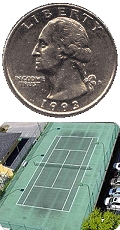 Choose the most appropriate
(reasonably close) answer...
Choose the most appropriate
(reasonably close) answer...
- The radius of a U.S. quarter is about:
- Which of the following units of Area is
the largest?
- 1 sq.yd.
- 1 sq.km.
|
- 1 sq.mi.
- 1 acre
|
- The area of a tennis court is about:
- 500 sq.in.
- 50 sq.yd.
|
- 5000 sq.ft.
- 5 acres
|
- Choose the most appropriate
(reasonably close) answer for each of the
following as it corresponds to a
(standard-sized) CD or DVD...
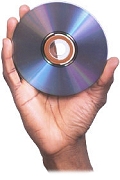
- The diameter of the disc is:
- The disc's circumference is
approximately:
- The area of the disc is approximately:
- 1 ft2
- 100 mm2
|
- 100 in2
- 100 cm2
|
 |
Determine (by measurement and
calculation) the approximate Area
of each of the following (state the
answer in the indicated units):
|
- an average-sized desktop (ft2)
- a credit card (cm2)
- a sheet of notebook paper (in2)
- a U.S. dollar bill (cm2)
|
-
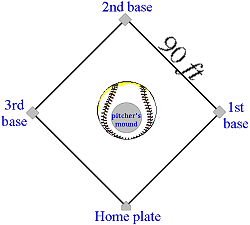 A baseball infield (diamond) is a square where
each side measures 90 feet
in length. If a batter hits a homerun, then
find each of the following:
A baseball infield (diamond) is a square where
each side measures 90 feet
in length. If a batter hits a homerun, then
find each of the following:
- the minimum distance he must run?
- his average running speed if it takes 25
sec for him to run around
the bases. Express the answer in
miles per hour?
- How far must the catcher (positioned at home
plate) throw the baseball in order throw out a
runner who is attempting to steal second base?
 |
A television screen (or picture
tube) is a rectangle whose
size is given by its
diagonal length. If a TV
screen has a length of 17.6"
and a width (or height) of 13.2",
then what will be the television
set's size?
|
- Using the floorplan in the illustration,
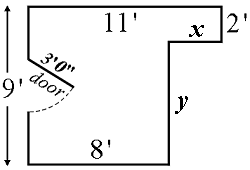 below right, determine each of the following:
below right, determine each of the following:
- The lengths of the walls which are
labeled "x" and "y."
- How much carpet will be needed to cover
the floor in square feet?
- If the carpet sells for
$12.99 per
sq.yd., how much will it cost?
- If padding cost $2.75
per sq.yd. and the
installation costs are
$125, what is the total
cost of carpeting the room?
- Baseboard costs $1.09
per (linear) foot, while the
installation costs are
$45 for the room. What
will be the total cost of running baseboard
around the walls?

- If the Earth is drawn or modeled to a scale
of 1 inch = 2000 km,
then what (scaled) distance represents the
Earth's:
a. diameter? b.
Circumference?
- a. What is the (equatorial) circumference
of the Earth measured in miles?
b. What would be the
average (linear) speed of a person/object
located at the equator due to the Earth's daily
rotation measured in mi
per hr?
- The (average) distance between Sun and the
Earth is about 93 × 106
miles. Assuming the path of its
annual revolution is a circular one, find the
average (linear) speed at which the Earth is
moving while orbiting the Sun? Express the
answer in miles per
hour.

- The planet
Venus revolves around the Sun in an almost
perfectly circular orbit. If the (average)
distance between the Sun and
Venus is 108,209,000 kilometers
and it completes one revolution
every 224.7 days, then how fast
is the planet moving in mph?
-
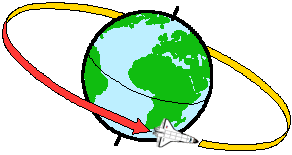 NASA's space shuttles frequently orbit the Earth
nearly 200 miles
above the surface (of the Earth), and they
travel at speeds of about 17,500 mph.
If a space shuttle circles the Earth at this
altitude and speed, then how long will it take
it to circumnavigate the Earth once?
NASA's space shuttles frequently orbit the Earth
nearly 200 miles
above the surface (of the Earth), and they
travel at speeds of about 17,500 mph.
If a space shuttle circles the Earth at this
altitude and speed, then how long will it take
it to circumnavigate the Earth once?
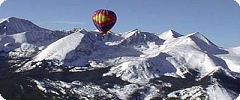 |
A hot-air balloon flies at an
altitude of 5000 ft
above sea level. If the balloon
travels around in the Earth in a
circular path once in a period of
two weeks, find the balloon's
average speed (in mph).
|
- A tablecloth for the round table in the
illustration (below) needs to overhang the edge
by 4".
- How much material (in ft2)
is required?

Caution: you cannot buy a round piece of
fabric.
- If a local fabric retailer has suitable
material at a cost of
$5.99
per square yard, then what will
be the cost of the material needed?
- What percentage of the fabric material
is not used and what is the cost of the
non-used material?
- At Pizza Hut,
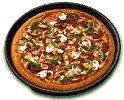
 a medium supreme pizza (12"
diameter) sold for $15.61
while a large supreme pizza (16"
a medium supreme pizza (12"
diameter) sold for $15.61
while a large supreme pizza (16" diameter) costs $19.78.
diameter) costs $19.78.
- Find the unit price (e.g., per
square inch) for each pizza.
- How much less expensive is the large
pizza than the medium pizza per unit area?
-
 Little
Little Caesar's Pizza restaurant at one time used to
offer two square pizzas, where each side was 12 in
long, for $18.99.
At the same time, it also sold a single large,
round pizza whose diameter was 16 in
for $14.99.
Which pizza purchase was the more economical
buy? Explain by citing both of their respective
unit prices.
Caesar's Pizza restaurant at one time used to
offer two square pizzas, where each side was 12 in
long, for $18.99.
At the same time, it also sold a single large,
round pizza whose diameter was 16 in
for $14.99.
Which pizza purchase was the more economical
buy? Explain by citing both of their respective
unit prices.
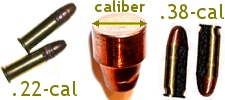 The measure of a bullet's cross-sectional
diameter determines its "caliber."
For example, a .22 caliber
bullet measures 22/100 inches.
How many times larger is the cross-sectional
area of a .38 caliber bullet
than a .22 caliber bullet?
The measure of a bullet's cross-sectional
diameter determines its "caliber."
For example, a .22 caliber
bullet measures 22/100 inches.
How many times larger is the cross-sectional
area of a .38 caliber bullet
than a .22 caliber bullet?
- Population
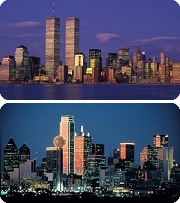 density is defined as the number of
people per unit area (e.g., per
square mile).
density is defined as the number of
people per unit area (e.g., per
square mile).
- New York City covers approximately 301.5
square miles of land and it
had a population of about 8.01 million
people (in 2000). What was the
population density of NYC in the year 2000?
- Dallas, Texas covers approximately 331.4
square miles of land and it
had a population of about 2.22 million
people (in 2000). What was the
population density of Dallas in the year
2000?
- Approximately how many times more
crowded (dense) was NYC than Dallas (in the
year 2000)?
|

